Italian Tuna Loaf (Polpettone di Tonno)
Italian Tuna Loaf or polpettone di tonno is a light and delicious seafood variation on the classic meatloaf. With the everyday staples of canned tuna, breadcrumbs, Parmesan, eggs, plus a little garlic and parsley, the result is a subtle savoury flavour. Wrapped then gently simmered in water rather than baked, the texture is beautifully moist.
Traditionally eaten cold as a lighter second course, Italian Tuna Loaf makes a great lunch or easy dinner served with a salad and lemony mayonnaise.
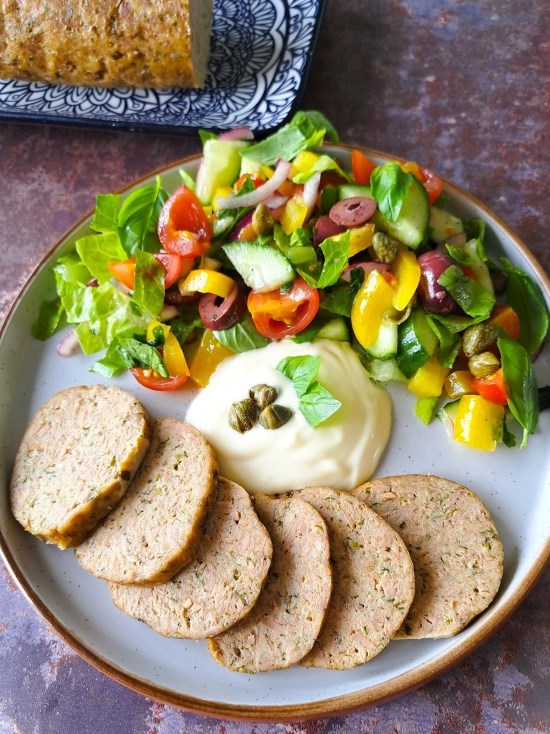
Jump to Recipe
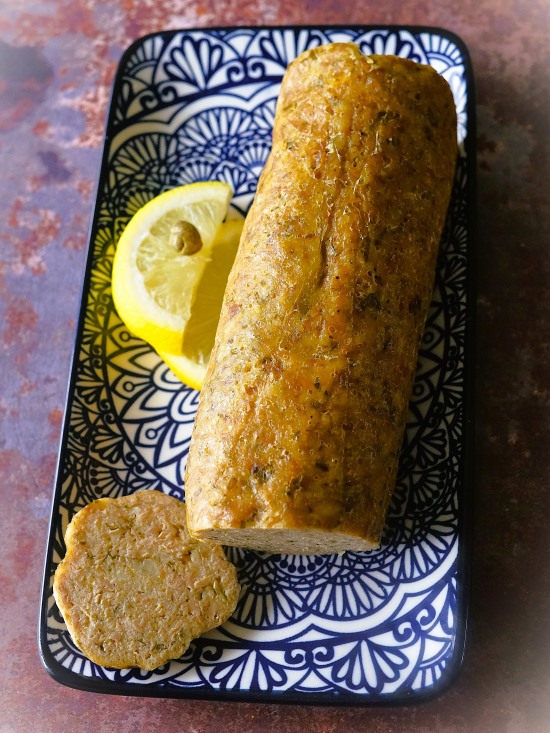
WHAT IS POLPETTONE?
It was only a few years ago I learned (from one of Claudia Roden’s lesser known-books Picnic: The Complete Guide to Outdoor Food) that Italy is the country with the greatest variety of meatloaves. It was when I was doing background reading for my Italian Pork Meatloaf that I discovered the world of polpettone.
Polpettone literally translates as ‘big meatball’. Which is completely fitting as polpettone have classic meatball flavours but in a sliceable loaf which you can eat hot or cold.
The simplest polpettone are just minced meat flavoured with things like Parmesan, herbs, and garlic, bound with egg then baked. Others might be stuffed with boiled eggs, cheese, cured meats, or spinach.
But I’ve now found a completely different, seafood-based Italian savoury loaf to fall in love with. Polpettone di Tonno with tinned tuna.

ITALIAN TUNA LOAF (POLPETTONE DI TONNO)
Light and with a delicate taste, Italian Tuna Loaf or Polpettone di Tonno is traditionally served as the secondo or second course following the often heavier primo which might feature substantial pasta or rice dishes. But it’s also perfect for a simple stand-alone lunch, easy dinner served with a salad, or part of a buffet meal. Normally served cold, it’s a great summer dish that’s conveniently made in advance and will keep for several days.
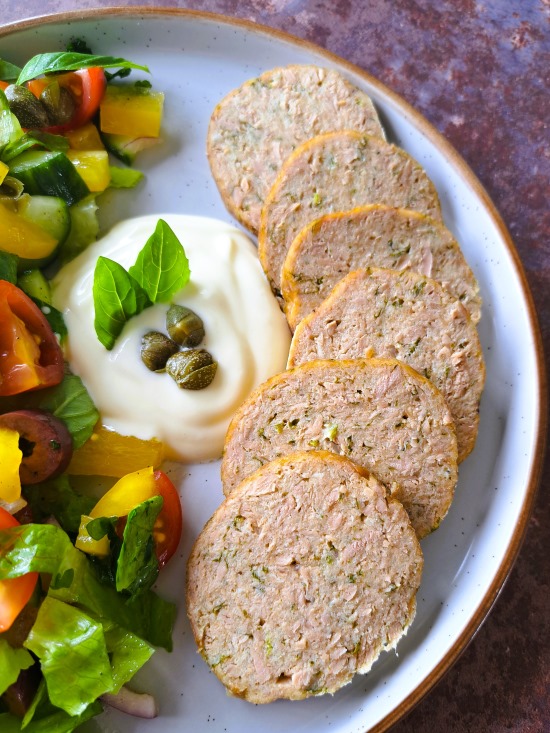
The basic ingredients are everyday staples that I always have in. As well as tuna canned in olive oil, there’s breadcrumbs (although some recipes are potato based instead), Parmesan, eggs, salt, and pepper. The result is not a strong fish or cheese taste, rather a delicious light and savoury flavour. Sometimes other things are added such as olives, capers, anchovies, or lemon zest. For my recipe, I’ve gone with a little fresh garlic and parsley.
Besides a good mixed salad dressed with a simple vinaigrette, the only thing I serve alongside my Italian Tuna Loaf is mayonnaise. This seems to be the traditional accompaniment, although I cheat by using jarred mayo which I flavour with a squeeze of lemon and a little extra virgin olive oil. I like to top it with piquant capers too.
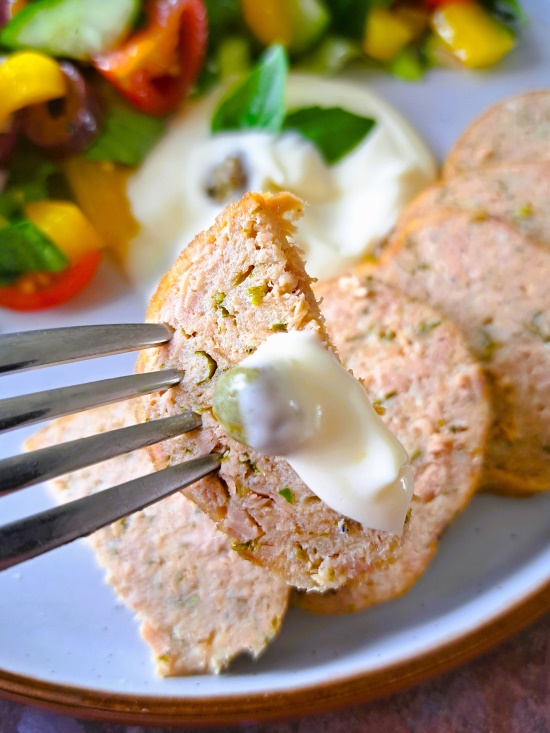
MAKING ITALIAN TUNA LOAF
Apart from the obvious one of being made with fish instead of meat, the main difference between a classic baked meatloaf and polpettone di tonno is that it’s simmered in water. Although some modern recipes do cook the loaf in the oven, I’ve found that the water-based method gives a lovely moist and delicate result.
You’ll find full instructions and ingredient amounts in the recipe card at the end. But I recommend reading this whole blog post first for extra tips and step-by-step images.
MIX THE INGREDIENTS
My recipe serves four people for which you’ll need 2 standard tins of tuna packed in oil. After draining off most, but not all, of the oil you should have around 200 – 225 grams of tuna. I don’t discard all the oil as leaving a little on the fish adds to the flavour and texture of the loaf.
All you do is tip the tuna into a mixing bowl along with the breadcrumbs, finely grated Parmesan, chopped or grated garlic, the parsley, and some black pepper. Season it lightly with salt, depending on how salty your tuna is and your liking for salt. Then use a fork to mix everything together. As you do this, break up the tuna so it’s in small flakes.
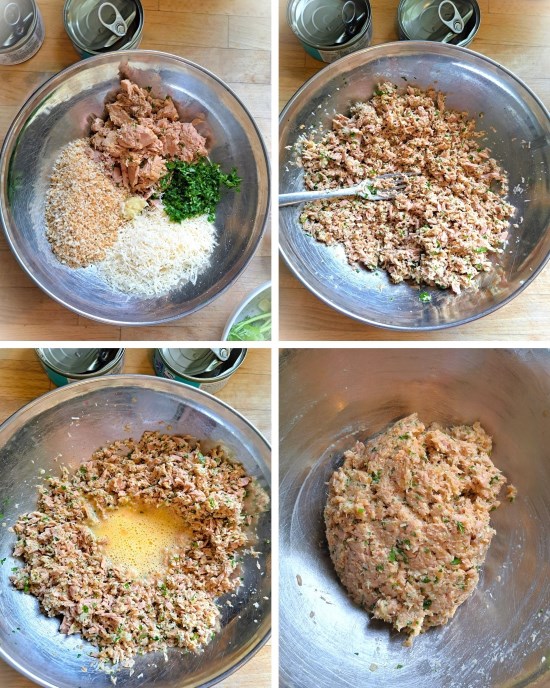
Crack the eggs into a separate bowl, add another small pinch of salt, and beat with your fork. Tip this into the tuna mix then switch to a silicone spoon and stir well to combine all the ingredients.
SHAPE THE LOAF
To make sure the loaf is shaped nicely, and stays that way during cooking, I use three types of wrapping. Cling film, baking paper, plus two layers of foil. To be honest, you’d probably get away without the paper, but I take a belt-and-braces approach.
Start by placing a large piece of cling film on your worksurface with a short side facing you. Transfer the tuna mix onto the cling film, a few centimetres up from the bottom edge. Now use your hands to shape it into a rough log. When doing this, bear in mind that it will need to fit into a saucepan and that, once in its layers of wrapping, it will be larger. In other words, don’t make it too long.
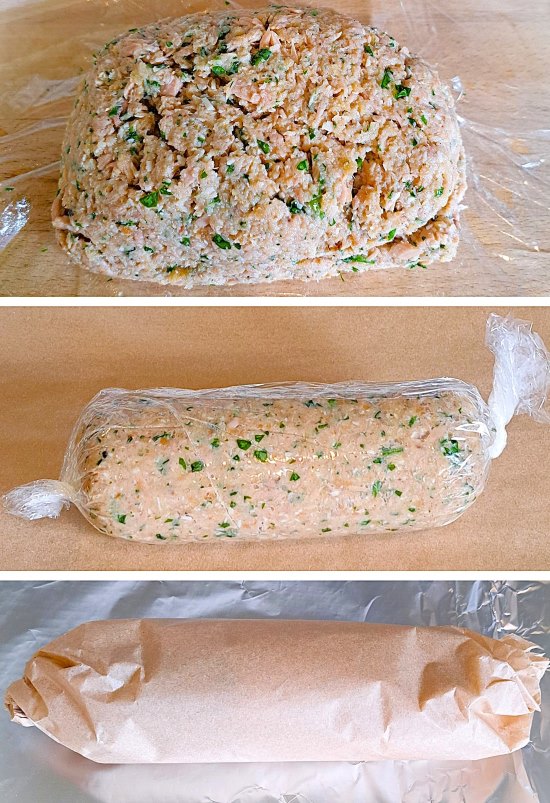
Roll the mix tightly inside the cling film into a cylinder shape. Then twist both the ends to close it like a Christmas cracker or a wrapped sweet. Now, holding a cling film ‘ear’ in each hand, roll the cylinder up and down the work surface several times. This should get it nice and smooth and even.
Next, put the cylinder on a large sheet of baking paper and wrap up tightly. Twist the ends as before to close. This time, cut the ‘ears’ off though. This will make it easier to get the all-important foil layers on.
Now enclose the package in a large sheet of foil, this time folding in the ends rather than twisting them. Repeat with a second sheet of foil, making sure that the second open long side doesn’t line up with the first.
COOKING & STORING ITALIAN TUNA LOAF
To cook the Italian Tuna Loaf I pour cold water into my largest saucepan (the one I make jam in) than add the package. Then you put on a lid and let it come to the boil. With such a large pan, this does take time. But I think that’s better than starting off in boiling water from a kettle and risking the loaf coming apart.
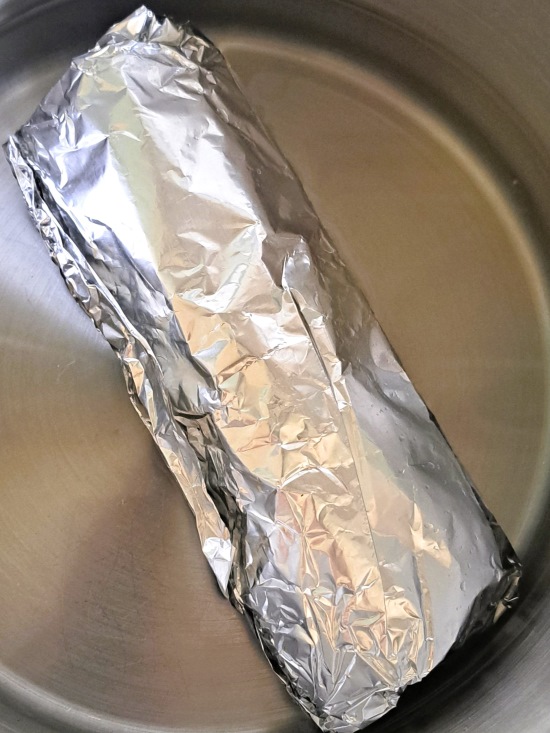
When it comes to a boil, turn the heat down to a simmer. Leave to cook for 40 minutes. You’ll probably find that the package bobs up to the top of the water, so I just turn it over halfway through for even cooking.
When it’s done, remove from the water but leave for a few minutes until cool enough to handle. Then completely unwrap the loaf, discarding the cling film, paper and foil. Transfer to a platter and put in the fridge. Leave until completely cold before slicing with a sharp knife so it doesn’t fall apart.
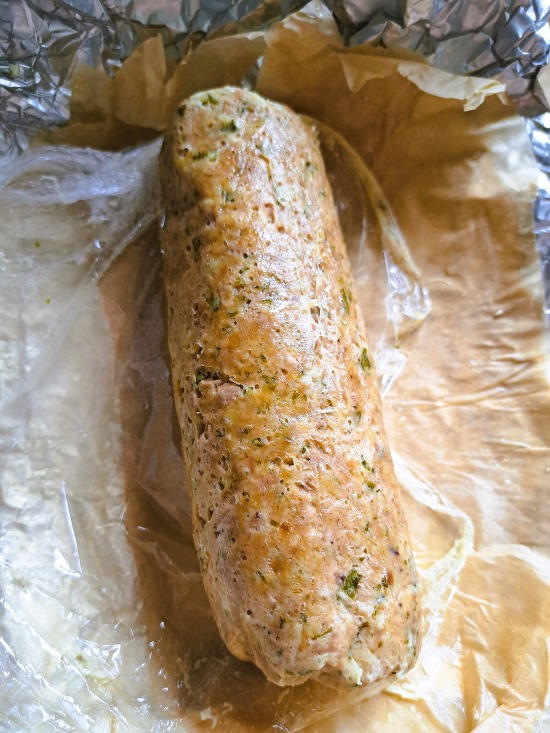
When it’s cold, wrap the Italian Tuna Loaf in cling film. Stored in the fridge like this, it should keep well for 2 – 3 days.
EASY, DELICIOUS, LIGHT & DELICATE POLPETTONE DI TONNO
I couldn’t be more pleased with my discovery of polpettone di tonno. Light and delicate, with a subtle savoury flavour, Italian Tuna Loaf was also surprisingly easy to make.
Wrapping and simmering foods in water isn’t something I do often. So I was a little concerned how things would go. Would the loaf stay together? Would it become waterlogged or end up stodgy? As all the recipes I saw had varying proportions of tuna, breadcrumbs, and cheese, I also didn’t know if mine, made by feeling my way via instinct, would work at all. Happily, it turned out beautifully the very first time.
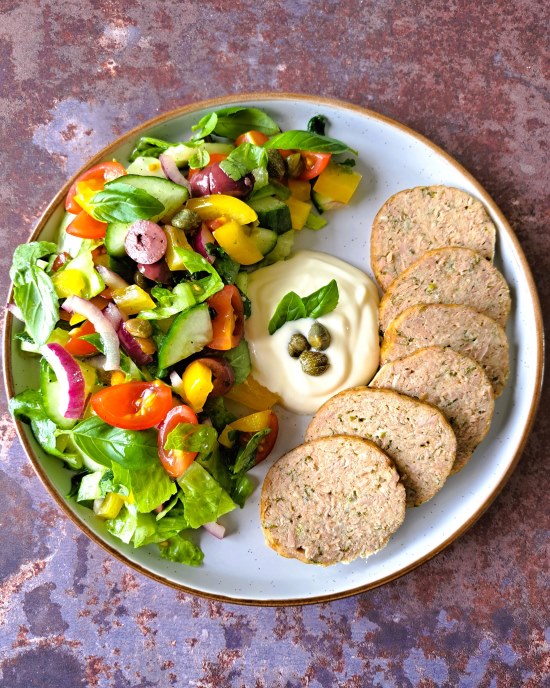
In the current warm weather, the loaf’s been great to have tucked away in the fridge. Over several days, I can create wonderful lunches and light dinners with just a few dressed salad vegetables to prepare plus a spoon of lemony mayonnaise.
If you’ve made this recipe, I’d love to know what you thought. Please do leave a comment and rating.
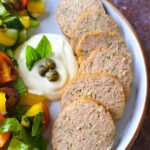
Italian Tuna Loaf (polpettone di tonno)
A light and delicious seafood variation on the classic meatloaf, this is made with canned tuna and simmered rather than baked for a beautifully moist texture.
Traditionally eaten cold as a lighter second course, Italian Tuna Loaf makes a great lunch or easy dinner served with a salad and mayonnaise (if using jarred mayo stir in a little lemon juice and olive oil) topped with capers.
It's recommended that you read the accompanying blog post before starting the recipe.
Ingredients
- 200 - 225 g tuna tinned in olive oil (approximate weight of 2 standard tins after draining off most of the oil)
- 40 g fresh white breadcrumbs
- 30 g Parmesan cheese (finely grated)
- 1 clove garlic (finely chopped or grated)
- 1 rounded tbsp finely chopped parsley
- ¼ tsp black pepper
- salt
- 2 med-large eggs
Instructions
-
Mix the ingredients
Drain most of the oil from the tuna but leave a little so it's still moist.
Tip into a mixing bowl along with the breadcrumbs, Parmesan, garlic, parsley, and black pepper. Season lightly with salt, depending on how salty your tuna is.
Use a fork to mix everything together, breaking up the tuna so it's in small flakes.
Crack the eggs into a separate bowl, add a small pinch of salt, and beat together.
Tip the eggs into the tuna mix.
Switch to a silicone spoon and stir well to combine all the ingredients.
-
Wrap the tuna loaf
Put a large piece of cling film on your worksurface with the short side facing you.
Tip the tuna mix onto the cling film a few centimetres up from the bottom edge and shape into a rough log (when deciding how long, remember that it will need to fit into a saucepan).
Enclose the mix in the cling film by rolling into a cylinder, twisting the ends to close it like a Christmas cracker or wrapped sweet. Holding each end of the cling film, roll the cylinder up and down the work surface a few times so it's smooth and even.
Put the cylinder on a large sheet of baking paper and wrap up tight. Twist the ends as before, but cut them off this time.
Now enclose in a large sheet of foil, this time folding in rather than twisting the ends.
Repeat with a second sheet of foil, ensuring that the second open edge doesn't align with the first.
-
Cooking
Fill a large saucepan with cold water and put the tuna parcel inside.
Bring up to the boil then simmer for 40 minutes.
Tip: the parcel is likely to bob up to the top of the water so turn over halfway through for even cooking.
-
Remove the parcel from the water and leave for a few minutes until cool enough to handle.
Completely unwrap and discard the cling film, paper and foil.
Transfer to a platter in the fridge and leave until cold before slicing.
-
Will keep for 2 - 3 days wrapped in fresh cling film in the fridge.



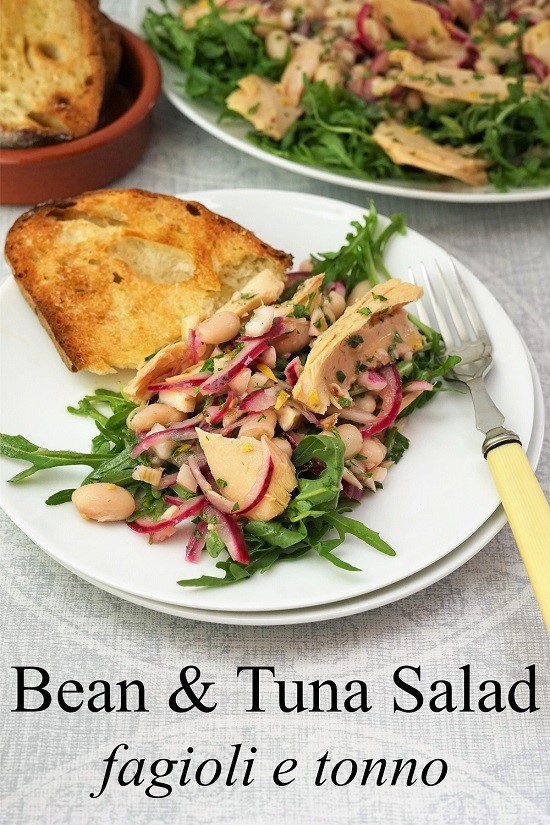
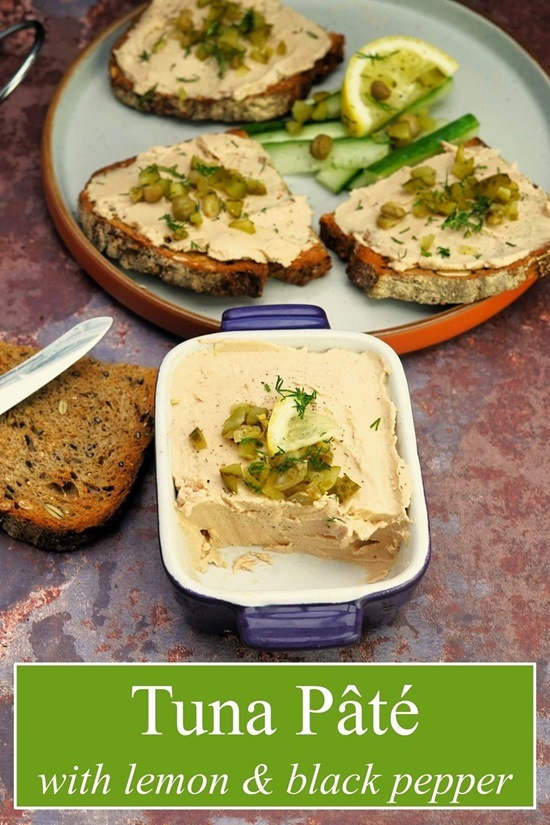
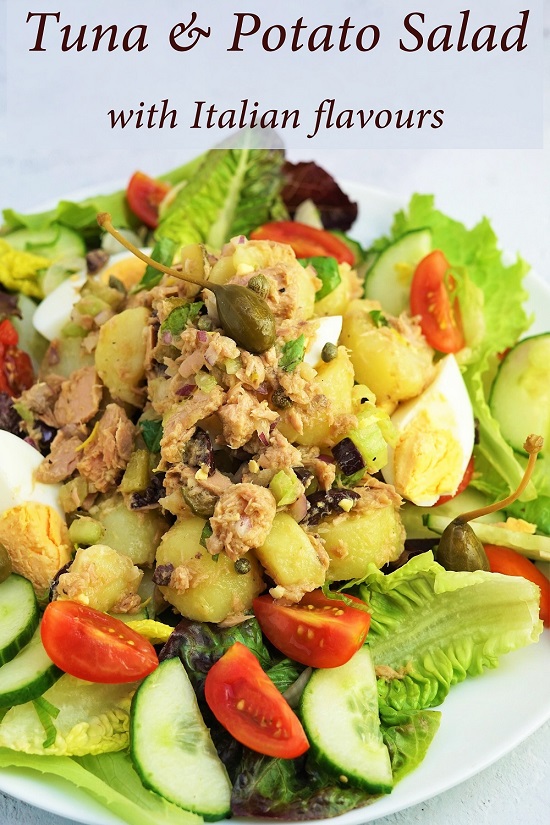

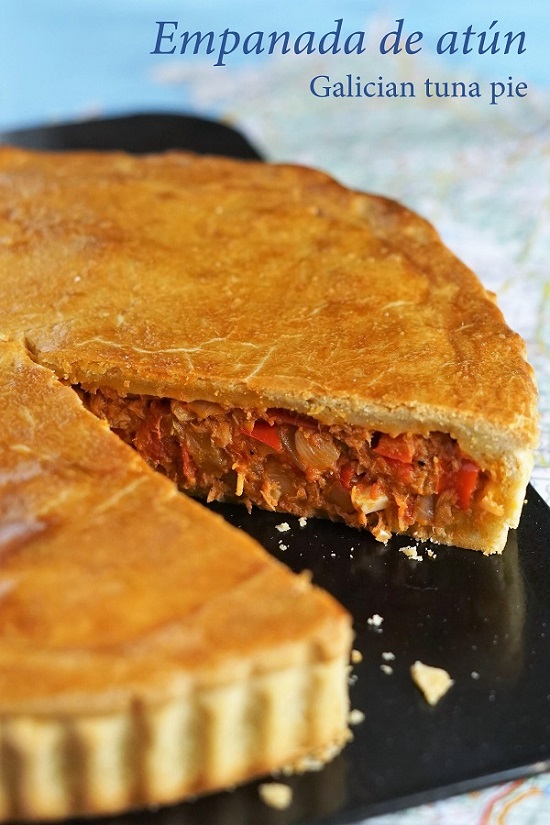
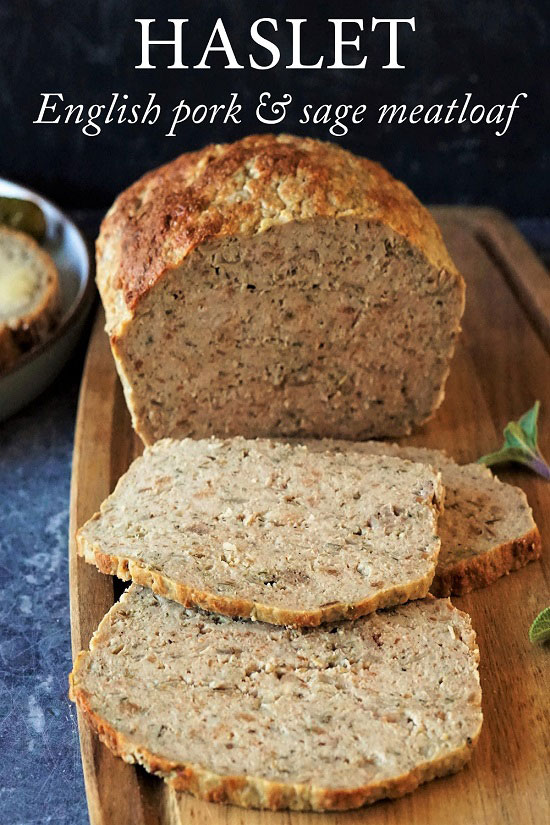
This was an absolute winner when I made it for dinner yesterday. Served it with a tomato salad, leaves and a remoulade. Absolutely delicious and will be a regular repeat I think!
So pleased you enjoyed it!